Serviços Personalizados
Journal
Artigo
Indicadores
-
 Citado por SciELO
Citado por SciELO -
 Acessos
Acessos
Links relacionados
-
 Similares em
SciELO
Similares em
SciELO
Compartilhar
Ciência e Técnica Vitivinícola
versão impressa ISSN 0254-0223
Ciência Téc. Vitiv. vol.26 no.2 Dois Portos 2011
Effect of cyclodextrins on off-odours removal of red wine: An innovative approach
G. Botelho1,2*, C. Valiau1, A. Moreira da Silva1,3
1Department of Food Science and Technology, Coimbra College of Agriculture, Polytechnic Institute of Coimbra, Bencanta, 3040-316 Coimbra, Portugal
2CEA-CERNAS Research Unit, Coimbra College of Agriculture, Polytechnic Institute of Coimbra, Bencanta, 3040-316 Coimbra, Portugal
3Physical-Chemistry Research Unit, University of Coimbra, 3000-535 Coimbra, Portugal
SUMMARY
The development of yeasts Brettanomyces spp. in wines can lead to the accumulation of 4-ethylphenol and 4-ethylguaiacol. The presence of these compounds in red wines above certain concentrations can cause spoilage and severe economic losses. Cyclodextrins (CDs) could be used to remove and mask undesirable component and control release of desired food constituents. The aim of this work is to study the removal effect of off-odours from red wine using β-cyclodextrin. Triangular and ranking sensory tests with 14 panellists were conducted with a red wine spiked with 4-ethylphenol (5000 µg/L) or a mixture of 4-ethylphenol (750 µg/L) + 4-ethylguaiacol (75 µg/L), and with different concentration levels of β-CD. According to the sensory panel, a concentration of 11.52 g/L of β-CD (ratio of 2:1) was enough to reduce the off-odours perception from red wine. Finally, a statistically significant increase of colour intensity (CI) and total polyphenols index (TPI) was found when red wine was treated with β-CD.
Key words: 4-ethylphenol; 4-ethylguaiacol; β-cyclodextrin; red wine; off-odours
Efeito de ciclodextrinas na remoção de odores desagradáveis em vinho tinto: Uma abordagem inovadora
RESUMO
O desenvolvimento de leveduras Brettanomyces spp. em vinhos pode levar à acumulação de 4-etilfenol e 4-etilguaiacol. A presença destes compostos em vinhos tintos acima de determinadas concentrações pode causar estragos e custos económicos avultados. As ciclodextrinas (CDs) podem ser usadas para remover ou mascarar componentes desagradáveis e controlar a libertação de constituintes desejáveis em alimentos. O objectivo deste trabalho é o de estudar o efeito de remoção de odores desagradáveis de vinho tinto utilizando para tal a β-ciclodextrina. Foram conduzidos testes sensoriais triangulares e de ordenação com 14 provadores, utilizando um vinho tinto enriquecido com 4-etilfenol (5000 µg/L) ou uma mistura de 4-etilfenol (750 µg/L) + 4-etilguaiacol (75 µg/L) e com diferentes níveis de concentração de β-CD. De acordo com o painel sensorial, a concentração de 11,52 g/L de β-CD (razão de 2:1) foi suficiente para reduzir a percepção de odores desagradáveis no vinho tinto. Finalmente, foi detectado um aumento estatisticamente significativo de intensidade corante e do índice de polifenóis totais no vinho tinto quanto tratado com β-CD.
Palavras-chave: 4-etilfenol; 4-etilguaiacol; β-ciclodextrina; vinho tinto; odores desagradáveis
INTRODUCTION
The involvement of yeasts in the winemaking process has gained increasing attention over the years as they play a central role in determining wine quality. Yeast of the genus Brettanomyces or its teleomorph Dekkera are among the many naturally occurring types of yeast in the winemaking process. However, Brettanomyces yeasts, in particular Brettanomyces bruxellensis, are regarded as spoilage microorganisms with the potential to drastically alter the final outcome or red wine under uncontrolled conditions (Suárez et al., 2007). These yeasts are highly adapted to grow and survive in red wine and can have detrimental effects on the visual and organoleptic quality of wines by causing film formation and cloudiness (Fugelsang, 1997), loss of colour (Mansfield et al., 2002), increase of volatile acidity (Aguilar-Uscanga et al., 2003), and the formation of phenolic off-flavours (Chatonnet et al., 1992, 1995, 1997; Loureiro and Malfeito-Ferreira, 2003; Dias et al., 2003). Volatile phenols in red wine (Figure 1), 4-ethylphenol and 4-ethylguaiacol, are produced by Brettanomyces bruxellensis from grape-derived p-coumaric acid and ferulic acid, respectively (Chatonnet et al., 1992; Suárez et al., 2007).
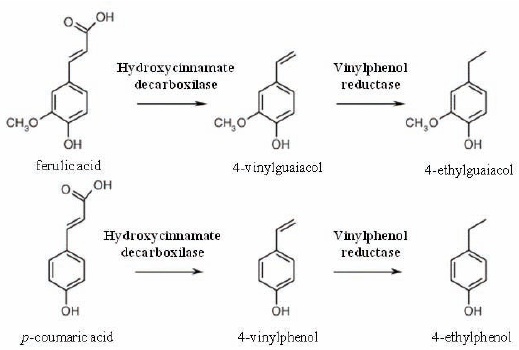
Figure 1 - Formation of ethylphenols from their hydroxycinnamic precursors.
Formação de etilfenóis a partir dos seus precursores hidrocinâmicos.
The aroma associated with 4-ethylphenol in red wine has been described as animal, horsy, barnyard, medicinal-like, smoky (Chatonnet and Boidron, 1988; Towey and Waterhouse, 1996) whereas 4-ethylguaiacol has been described as a smoky, spicy, clove-like aroma (Aiken and Noble, 1984; Chatonnet and Boidron, 1988). At low concentrations, these compounds are through by some to add to wine complexity, but at high concentrations the wine is considered spoiled and the Brett character of the aroma is clear. In wine industry, the production of 4-ethylphenol in red wines is only regarded as spoilage when this compound is present at levels higher than about 620 µg/L. At less than 400 µg/L, it contributes favourably to the complexity of wine aroma (Chatonnet et al., 1992, 1993). Some strategies to avoid the problem previously reported have been performed without success (Renouf et al., 2008). Thus, we present, in this study, an alternative way to remove red wine off-odours by cyclodextrins (CDs).
Cyclodextrins are carbohydrates composed of α-1,4-linked glucopyranose, also called glucose units, where the glucopyranose molecules are arranged to form a ring (Figure 2) which look like a bottomless bucket. The outer side of this ring has a molecular structure which gives it solubility in water (as other simple carbohydrates), while the inside repels water, favouring molecules that are insoluble in water. These molecules, dissolved or dispersed in water, have a preference for being in the cavity rather than in water (Duchene et al., 2003).
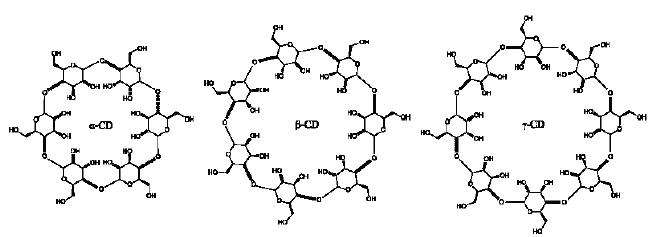
Figure 2 – Chemical structures of α-, β- and γ-cyclodextrins.
Estruturas químicas das α-, β- e γ-ciclodextrinas.
When the host molecule is in the cavity, are not covalent forces which prevent them from leaving, but atomic (Van der Waals), thermodynamic (hydrogen bonding), and solvent (hydrophobic) ones in the hydrophobic environment of the CD cavity (Astray et al., 2009). These links can be destroyed easily by heating, pH changing, and others. A complex can be formed if a balance exists between the relative concentrations of the CD and the potential guest chemical. The rate at which the associated complex is formed is determined by the accessibility of the guest molecule to the CD cavity and the magnitude of the thermodynamic driving force. Hydrophobic guest molecule is removed from the aqueous environment, while water molecules previously associated in the CD cavity return into aqueous environment, thats why this binding is energetically favourable (Singh et al., 2002). CDs without treatment are stable, white, and crystalline powders. They can form inclusion complexes with a lot of molecules including flavours or colourant compounds. Size and hydrophobicity are the main criteria to succeed an inclusion complex.
In fact, CDs produced due to the transformation of starch by certain bacteria (e.g. Bacillus macerans), are cyclic oligomers widely used in the food industry as food additives, for stabilisation of flavours, for elimination of undesired tastes or other undesired compounds and to avoid microbiological contaminations and browning reactions. Some examples of the production of manufactured food products by a cyclodextrin-assisted technology using a selective complexation/sequestration of selected components by empty cyclodextrins are the low-cholesterol butter and eggs, under the tradename of Balade (Comini and Mentink, 1991), and Simply Eggs (USA), respectively (Szente and Szejtli, 2004).
Based on this knowledge, and trying to solve a serious winemaking problem, our main goal was to test the removal of red wine off-odours by cyclodextrin-assisted technology.
MATERIAL AND METHODS
Samples
Commercial table red wine with 11.5 % vol. of alcohol content and pH of 3.5. The wine from 2008 vintage presented the malolactic fermentation finished and was obtained from the marketplace.
Reagents
β-CD was kindly donated by Wacker-Chemie, Munchen (Germany). 4-Ethylphenol was purchased from Fluka Chemie (Buchs, Switzerland) and 4-ethylguaiacol was purchased from TCI Europe nv (Zwijndrecht, Belgium). Water was deionised (conductivity < 0.1 mS/cm obtained through an Elix 3 type II from Millipore (Water Purification Systems, USA).
Sample preparation
Assay of red wine with 4-ethylphenol
The volatile phenol 4-ethylphenol was weighed and added to 500 mL of red wine to reach a concentration of 5000 µg/L. β-CD was added to three replications of 100 mL of contaminated wine, to reach a concentration of 2.88, 5.76 and 11.52 g/L. These weights have been calculated to reach a ratio of 0.5:1, 1:1 and 2:1, respectively. After the addition of β-CD, each sample has been mixed until complete dissolution of β-CD and stored at ±6ºC during 16 hours. Then, the solutions were filtrated and subsequently analysed by spectrophotometry and sensory analysis.
Assay of red wine with 4-ethylphenol + ethylguaiacol
Red wine (500 mL) was spiked with 4-ethylphenol and ethylguaiacol to reach the added concentration of 750 µg/L of 4-ethylphenol and 75 µg/L of 4-ethylguaiacol. Then, β-CD was added to 3 solutions of 100 mL of contaminated wine, to reach a concentration of 2.88, 5.76, and 11.52 g/L. These weights have been calculated to reach a ratio of 0.5:1, 1:1 and 2:1, respectively. After the addition of β-CD, each sample has been mixed until complete dissolution of β-CD and stored at ±6ºC during 16 hours. After that, the solutions were filtrated and subsequently analysed by spectrophotometry and sensory analysis.
CI and PTI analysis
A spectrophotometer UV/VIS (Hitachi U2000, Tokyo, Japan) was used for the colour intensity (CI) and total polyphenols index (TPI) determination. Both methods were aforementioned described (OIV, 1990; Ribéreau-Gayon, 1970).
Sensory analysis
The sensory panel was composed by a group of 14 panellists (6 males and 8 females, 19-26 years old) with some experience in sensory analysis of food (students of Food Engineering degree), referred to as panellist 1, 2,..., 14. Two discrimination sensory tests were used: triangular test and ranking test. The 14 judges performed the triangular tests and 8 of them performed the ranking tests. The triangular and the ranking tests were performed as described by ISO 4120.2 (1983), ISO 6658 (1985) and ISO 8587 (1986). The samples were coded with three digit numbers and were presented to the subjects in random order to eliminate first order carry-over effects (Williams, 1949). An amount of 10 mL of red wine samples was given to each panel judge in wine tasting glasses at 20 ºC (ISO 3591, 1977). The samples were evaluated ortonasally.
Statistical analysis
The statistical interpretation of triangular tests was based on binomial distribution while for ranking tests the Friedman test was applied. The software package SPSS release 16.0 for Windows (SPSS Inc., Chicago, IL, USA) was used for analysis of variance (one-way ANOVA) and post hoc LSD test.
RESULTS AND DISCUSSION
The 4-ethylphenol presents a detection threshold of 230 µg/L in red wines (Chatonnet et al., 1990) while the combination of 4-ethylphenol + 4-ethylguaiacol shows a threshold of 400 µg/L (Chatonnet et al., 1992). Despite these values, it must be underlined that the detection threshold of ethylphenols in red wine is easely influenced by wine complexity. In fact, some volatile compounds other than volatile phenols have a sensory impact on the spoiled wine. For example, the isobutyric and isovaleric acids possess a masking effect above ethylphenols (Romano et al., 2009).
The concentration of 4-ethylphenol found in 61 bottled commercial Australian red wines of various ages ranged from 2 μg/L in a Merlot up to 2660 μg/L in a Shiraz, with a mean concentration of 795 μg/L. 4-Ethylguaiacol was also detected in every red wine analysed, ranging in concentration from 1 μg/L (in a Pinot Noir) up to 437 μg/L (in a Merlot) with a mean concentration of 99 μg/L (Pollnitz et al., 2000). Since the present work is focused on the determination of the off-odour removal, the wine samples were spiked with amounts of these volatile compounds which warranted that the off-odour presence in wines was indubitable for the sensory panellists. By this, a concentration of 5000 µg/L of 4-ethylphenol was selected. Furthermore, the 4-ethylphenol / 4-ethylguaiacol ratio in red wines usually ranges from 3.5 to 16 (Chatonnet et al., 1992; Pollnitz et al., 2000). Therefore, in the present work, the concentrations of 750 µg/L of 4-ethylphenol and 75 µg/L of 4-ethylguaiacol (ratio of 10) were selected.
Sensory analysis of 4-ethylphenol removal from wine with β-cyclodextrin addition
Triangular test
Three different wine glasses numbered randomly were presented to the sensory panel. Two of them were only red wine, and one was the wine spiked with 4-ethylphenol. Panellists had to identify the odd sample.
The analysis of sensory data showed that 12 panellists correctly identified the odd sample, and only 2 failed. The critical number given by ISO 4120.2 (1983) for a number of panellists of 14, with an occurring error of 0.1% (α ≤ 0.001) is 11. So, the number of correct answers is superior to the critic number, which indicates that the sensory panel found correctly that red wine spiked with 4-ethylphenol presents a different aroma from simple red wine at the 0.1% level of significance.
Ranking test
In order to know which red wine is different from the other one, it was decided to do a ranking test with 5 glasses. One of the glasses contained only red wine (sample A), other glass contained the same red wine spiked with 4-ethylphenol in 5000 µg/L concentration (sample E), and each one of other three glasses contained the red wine spiked with the previous concentration of 4-ethylphenol and contained also the concentrations of 2.88 (sample D), 5.76 (sample C), and 11.52 (sample B) g/L of β-CD, respectively. The panellists had to rank all the solutions from the less intense to the most intense considering the 4-ethylphenol off-odour (animal, horse stable odour descriptors). After the calculations of Friedmans ranking test according to ISO 6658 (1985) and ISO 8587 (1986) and after the least significant difference (LSD) test, the final results were found (Table I).
TABLE I
Results of ranking test for 4-ethylphenol odour in wine.
Resultados do teste de ordenação do odor do 4-etilfenol no vinho.
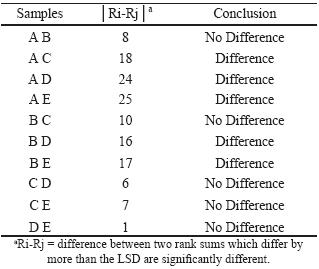
From the interpretation of this table we can conclude that no differences were found between samples A and B, which suggests that 11.52 g/L of β-CD is effective on the off-odour removal from red wine spiked with 4-ethylphenol. Moreover, the finding of no differences among the pairs of samples C D, C E and D E, indicates that lower quantities of β-CD are not adequate for the off-odour reduction in red wine.
Sensory analysis of 4-ethylphenol + 4-ethylguaiacol removal from wine with β-cyclodextrin addition
Triangular test
First, three different wine glasses numbered randomly were presented to the sensory panel. Two of them were only red wine, and one was the wine with 4-ethylphenol in 750µg/L concentration and 4-ethylguaiacol in 75µg/L concentration. Panellists had to find which solution was different.
The analysis of sensory data showed that 12 panellists found the correct wine, and only 2 failed. Like was found for red wine spiked with 4-ethylphenol, the sensory panel found correctly that red wine spiked with 4-ethylphenol + 4-ethylguaiacol presents a different aroma from simple red wine.
Ranking test
In order to know which red wine is different from the other one, it was decided to do a ranking test with 5 glasses, randomly numbered, one of the glasses contained only red wine (sample A), another glass of wine contained 4-ethylphenol in 750 µg/L concentration and 4-ethylguaiacol in 75µg/L concentration (sample E), and the remaining three glasses of wine contained the previous amounts of both phenols and different concentrations of β-CD (2.88 (sample D), 5.76 (sample C), 11.52 (sample B) g/L). The panellists had to rank all the solutions from the less intense to the most intense in 4-ethylphenol and 4-ethylguaiacol odour (animal, horse stable, spicy odour). After the calculations of Friedmans ranking test and after the least significant difference (LSD) test, the final results were found (Table II). From the interpretation of Table II we can conclude that no differences were found between samples A and B which suggests that 11.52 g/L of β-CD is effective on the off-odour removal from red wine spiked with 4-ethylphenol + 4-ethylguaiacol. In addition, the panellists found differences among the samples B, C, D and E which indicates that they found different intensities of off-odours in those samples.
TABLE II
Results of ranking test for 4-ethylphenol + 4-ethylguaiacol odour in wine.
Resultados do teste de ordenação do odor do 4-etilfenol + 4-etilguaiacol no vinho.
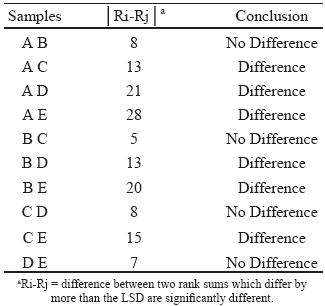
Effect of β-CD on red wine IC and TPI analysis
The colour intensity (IC) and total polyphenols index (TPI) of simple red wine (control wine) or the same red wine spiked with 4-ethylphenol or with 4-ethylphenol + 4-ethylguaiacol and with the addition of decreasing amounts of β-CD are present in Table III. From the observation of this table it can be concluded that the incorporation of β-CD in red wine increased significantly the colour intensity and total polyphenols index. These results are of great interest for the winemaking industry because the quality of red wines is greatly associated with their high colour intensity and also with the total polyphenols index. In a recent study, Andreu-Sevilla et al. (2011) studied the effect of β-CD on pear juice and they found that an addition of β-CD at a concentration of 15 mM to pear juice, significantly increased its global quality, colour intensity and reduced its browning without any significant decrease in aroma quality.
TABLE III
Cyclodextrin effect on the total polyphenols index and on the colour intensity of wine.
Efeito da ciclodextrina no índice de polifenóis totais e na intensidade corante do vinho.
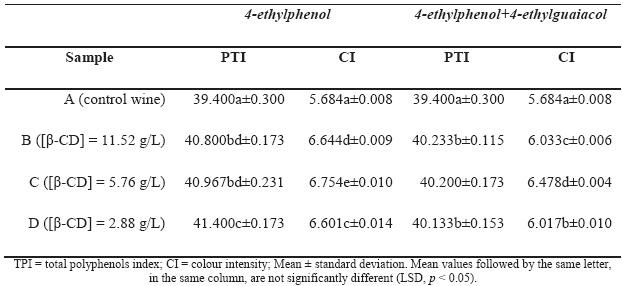
CONCLUSIONS
According to these preliminary results, the concentration of 11.52 g/L of β-CD (ratio of 2:1) was enough to remove the off-odours caused by 4-ethylphenol or 4-ethylphenol + 4-ethylguaiacol in a red wine. Furthermore, the addition of β-CD to red wine increased significantly the colour intensity and the total polyphenols index. This work is pioneering in the sense that it is, as far as we know, the first research work that proposes the use of β-CD as a new possible oenological adjuvant. Further research work is needed in order to quantify by gas chromatography the volatile phenols removed from red wine using β-CD.
REFERENCES
production. Appl. Microbiol. Biotech., 61, 157-162.Aiken J.W., Noble A.C. 1984. Composition and sensory properties of Cabernet Sauvignon wine aged in French versus American oak barrels. Vitis, 32, 27-36. [ Links ]
Andreu-Sevilla A.J., Carbonell-Barrachina Á.A., López-Nicolás J.M., García-Carmona F. 2011. Sensory quality, volatile compounds and coloro f pear juice treated with β-cyclodextrin. J. Incl. Phenom. Macrocycl. Chem., 70, 453-460. [ Links ]
Astray G., Gonzalez-Barreiro C., Mejuto J.C, Rial-Otero R., Simal-Gandara J. 2009. A review on the use of cyclodextrins in food. Food Hydrocolloids, 23(7), 1631-1640. [ Links ]
Chatonnet P., Boidron J.N. 1988. Dosages de phénols volatils dans les vins par chromatographie en phase gazeuse. Sci. Aliments, 8, 479-488. [ Links ]
Chatonnet P., Boidron J., Dubourdieu D. 1993. Influence des conditions délevage et de sulfitage des vins rouges en barriques sur le teneur en acide acétique et en ethyl-phenols. J. Int. Sci. Vigne Vin, 27, 277-298. [ Links ]
Chatonnet P., Boidron J., Pons M. 1990. Elevage des vins rouges en fûts de chêne: évolution de certains composés volatils et de leur impact arômatique. Sci. Alim., 10, 587-656. [ Links ]
Chatonnet P., Dubourdieu D., Boidron J., Pons M. 1992. The origin of ethylphenols in wines. J. Sci. Food Agric., 60, 165-178. [ Links ]
Chatonnet P., Dubourdieu D., Boidron J.N. 1995. The influence of Brettanomyces/Dekkera sp. yeasts and lactic acid bacteria on the ethylphenol content of red wines. Am. J. Enol. Vitic., 46, 463-468. [ Links ]
Chatonnet P., Viala C., Dubourdieu D. 1997. Influence of polyphenol components of red wines on the microbial synthesis of volatile phenols. Am. J. Enol. Vitic., 48, 463-468. [ Links ]
Comini S., Mentink L. 1991. Refining mixtures containing complexes of cyclodextrins with lipophilic compounds such as fatty acids. Eur Pat. Appl. EP 440539. [ Links ]
Dias L., Dias S., Sancho T., Stender H., Querol A., Malfeito-Ferreira M., Loureiro V. 2003. Identification of yeasts isolated from wine-related environments and capable of producting 4-ethylphenol. Food Microbiol., 20, 567-574. [ Links ]
Duchene D., Bochot A., Yu S.-C., Pepin C., Seiller M. 2003. Cyclodextrins and emulsions. Int. J. Pharma., 266(1-2), 85-90. [ Links ]
Fugelsang K.C. 1997. In: Wine microbiology. The Chapman and Hall Enology Library. New York. [ Links ]
ISO 3591. 1977. Sensory analysis – Apparatus – Wine-tasting glass. International Organization for Standardization, Genève. [ Links ]
ISO 4120.2. 1983. Sensory analysis methodology triangular test. International Organization for Standardization, Paris. [ Links ]
ISO 6658. 1985. Draft International Standard, ISO/DIS 6658, Sensory Analysis – Methodology – General Guidance. International Organization for Standardization, Paris. [ Links ]
ISO 8587. 1986. Draft International Standard ISO/DIS 8587, Sensory Analysis – Methodology – Ranking Test. International Organization for Standardization, Paris. [ Links ]
Loureiro V., Malfeito-Ferreira M. 2003. Spoilage yeasts in the wine industry. Int. J. Food Microbiol., 86, 23-50. [ Links ]
Mansfield A.K., Zoeklein B.W., Whiton R.S. 2002. Quantification of glycosidase activity in selected strains of Brettanomyces bruxellensis and Oenococcus Oeni. Am. J. Enol. Vitic., 53, 303-307. [ Links ]
OIV. 1990. Recueil des méthodes internationales danalyse des vins et des moûts. 368p., OIV, Paris. [ Links ]
Pollnitz A.P., Pardon K.H., Sefton M.A. 2000. Quantitative analysis of 4-ethylphenol and 4-ethylguaiacol in red wine. J. Chromatogr. A, 874, 101-109. [ Links ]
Renouf V., Strehaiano P., Lonvaud-Funel A. 2008. Effectiveness of dimethyldicarbonate to prevent Brettanomyces bruxellensis growth in wine. Food Control, 19, 208-216. [ Links ]
Ribéreau-Gayon P. 1970. Le dosage des composés phénoliques totaux dans les vins rouges. Chim. Anal., 52, 627-631. [ Links ]
Romano A., Perello M.C., Lonvaud-Funel A., Sicard G., de Revel G. 2009. Sensory and analytical re-evaluation of "Brett character". Food Chem., 114(1), 15-19. [ Links ]
Singh M., Sharma R., Banerjee U.C. 2002. Biotechnological applications of cyclodextrins. Biotechnology advances, 20(5-6), 341-359. [ Links ]
Suárez R., Suárez-Lepe J.A., Morata A., Calderón F. 2007. The production of ethylphenols in wine by yeasts of the genera Brettanomyces and Dekkera: A review. Food Chem., 102, 10-21. [ Links ]
Szente L., Szejtli J. 2004. Cyclodextrins as food ingredients. Trends in Food Sci. & Technol., 15, 137–142. [ Links ]
Towey J.P., Waterhouse A.L. 1996. Oak lactone isomer ratio distinguishes between wines fermented in American and French oak barrels. Am. J. Enol. Vitic., 47, 163-172. [ Links ]
Williams E. J. 1949. Experimental designs balanced for the estimation of residual effects of treatments. Aust. J. Sci. Res., A2, 149-168. [ Links ]
Acknowledgements
The authors thank the 14 subjects (students of Food Engineering degree at the Coimbra College of Agriculture) who participated in the sensory panel and thank Noémia Bárbara for the English revision.
(Manuscrito recebido em 30.06.11. Aceite para publicação em 23.08.11)
*Corresponding author: Goreti Botelho. Tel. +351 239802940, Fax +351 239802979, E-mail: goreti@esac.pt













